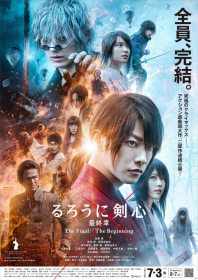
Despite the third film in this series being quite conclusively called The Legend Ends, it’s seven years later and it looks like the legend is very much not ending – instead, the series continues in the form of another two back-to-back sequels. You can say what you like about the Rurouni Kenshin films, but you can’t question their consistency: inventive, fast-paced action scenes; wacky characters; edgy, but without being too violent; political, but without anything to say; long and overwrought; and with decent performances. This fourth film is perhaps the most humourless and baggy so far, and although it is a pleasure to spend time in the company of these characters again, this instalment feels like we are going through the motions. The year is 1879 – 12 years into Japan’s ‘new age’ – and trouble is brewing, again. “It’s time you got used to peace,” says Sagara to his samurai friend, Kenshin, as cannon-fire levels the police department’s dojo and blows up the Chief’s house. It’s a blatant, unprovoked act of terrorism, but who could be the culprit? Well, it’s yet another ghost from Kenshin’s past (there’s been a few of these). Enishi Yukishiro (Mackenyu Arata, son of Sonny Chiba) is a cool, kung fu hippy in flowing garbs and miniature John Lennon specs, who turns out to be the brother of Tomoe Yukishiro (Kasumi Arimura), the fiancee of one of Kenshin’s samurai victims from an attack years previously – an attack which led to one of Kenshin’s two facial scars. We also learn that, despite killing her fiancee, Kenshin and Tomoe still became lovers and were actually married, only for Kenshin to then inadvertently cause her death too! By focusing the drama on personal tragedy, it allows the film to sidestep a potentially tricky depiction an increasingly industrialised China, after it is revealed that Enishi has made most of his wealth with the Shanghai mafia, and exploiting his connections at the very heart of the Qing government. Tensions between the two countries is only ever hinted at and never fully explored (by 1894, the two nations would find themselves at war). As a villain, Enishi strikes a more sympathetic tone, and because of his familial links, the stakes never feel too high. The film also forgets to have fun, despite some bonkers additions: an orc-like baddy in a Slipknot mask; hoards of bandit swordsmen dressed like Skeletor; and a guy with a machine gun for an arm. All of your favourite characters get to have their moment in the sun: from chain-smoking police officer, Saitō Hajime (Yōsuke Eguchi), to Kenshin’s boisterous buddy, Sagara Sanosuke (Munetaka Aoki); there are victory laps for former adversaries, like bleach-haired bandit, Sawagejō Chō (Ryōsuke Miura), and the creepy, hopping killer, Seta Sōjirō (Ryūnosuke Kamiki); Aoshi and Misao drop in from Kyoto – with Misao thankfully getting more opportunities to kick ass; and even Kaoru is afforded a more involving character arc, having to find resolution as part of Kenshin’s complicated love-life. It’s a decent romp, but it does feel like this series has probably run its course.
AKA: Rurouni Kenshin: Final Chapter Part I – The Final.
- Country: Japan
- Action Director: Kenji Tanigaki
- Directed by: Keishi Ōtomo
- Starring: Emi Takei, Mackenyu Arata, Munetaka Aoki, Ryunosuke Kamiki, Takeru Satoh, Tao Tsuchiya, Yōsuke Eguchi, Yū Aoi, Yûsuke Iseya
- Produced by: Hiroyoshi Koiwai, Satoshi Fukushima
- Written by: Keishi Ōtomo
- Studio: Warner Bros.












